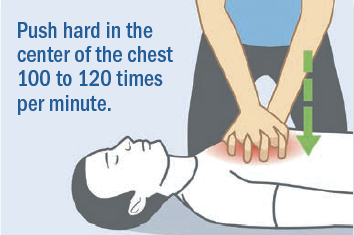The Importance of Bystander CPR

Image: © solar22/Getty Images
Every year, more than 350,000 Americans experience sudden cardiac arrest, when the heart stops beating without any warning. In the agonizing moments before paramedics arrive, there's no blood circulating in the body to deliver oxygen to the brain and other organs; death is just minutes away.
"When the cardiac arrest occurs outside of a hospital setting, the survival rate ranges from 2% to 15%," says Dr. Kei Ouchi, an emergency physician at Harvard-affiliated Brigham and Women's Hospital.
That grim reality has led to a national call to arms from the American Heart Association (AHA) to learn a simple, potentially lifesaving skill to help someone in cardiac arrest: an abbreviated form of cardiopulmonary resuscitation (CPR) known as bystander or hands-only CPR. The American Heart Association says when a bystander promptly performs CPR, it doubles or triples the survival rate.
What is bystander CPR?
Traditional CPR involves chest compression to manually keep the heart pumping, and also mouth-to-mouth resuscitation to provide oxygen to the person in cardiac arrest. Bystander CPR consists of only the chest compressions.
"They're both important," says Dr. Ouchi, "but when cardiac arrest occurs, there's already some oxygen left in the blood. We've learned it's much more important to pump that blood to the brain than spend the extra seconds or minutes trying to give the patient more oxygen. So now it's compression, compression, compression."
How do you do it?
Someone in cardiac arrest will collapse, stop breathing, and have no pulse. That's the time to begin bystander CPR. The first step is the most important: call 911. Once you've reported the emergency, you can begin chest compressions. Dr. Ouchi explains the process this way:
- Kneel next to the person's chest.
- Place the heel of one hand over the other in the middle of the chest.
- Extend your arms completely.
- Push down hard at a 90° angle (put your shoulders into it), and after the push completely release your pressure. That's one compression.
- Aim for 100 or more compressions per minute. It may help to sing to keep up your pace. A common recommendation is the Bee Gees' disco hit "Stayin' Alive," which has almost exactly 100 beats per minute. "You can get tired very quickly. Switch with someone to get a break," Dr. Ouchi says.
Recruiting CPR help
Numerous free smartphone apps can show you where to find an automated external defibrillator on a map or alert you to emergencies involving patients who need CPR until paramedics can arrive. One is Pulse Point Respond (www.pulsepoint.org), which has been adopted by 3,000 communities across the country. Another free smartphone app is Staying Alive (www.stayingalive.org). "We need more research to know if these apps make a difference, but we already know bystander CPR saves lives," says Dr. Kei Ouchi, an emergency physician at Harvard-affiliated Brigham and Women's Hospital.
Does it work?
Chest compressions can help push any remaining oxygenated blood to the organs to keep them alive. Not only can CPR prevent sudden death, the prognosis is good for the person who survives and is discharged from the hospital: the cardiac arrest usually does not leave them with brain damage or other medical problems. Indeed, a 2015 study of more than 4,000 people in Denmark, published May 12, 2015, in Circulation, found that more than 75% of people who survived a cardiac arrest that occurred outside a hospital were able to return to work in about four months. Those who received CPR from a bystander were nearly 40% more likely go back to work, compared with survivors who didn't get CPR.
Dr. Ouchi says that when CPR is accompanied by the use of an automated external defibrillator (AED) — which uses electricity in attempt to restart the heart — there's an even better chance for survival. AEDs are used only for certain kinds of irregular heartbeats.
Where can you learn it?
The AHA, American Red Cross, YMCAs, and even some local hospitals offer classes in bystander CPR. They may or may not be free. You can also watch this video that demonstrates the lifesaving skill: www.heart.org/HandsOnlyCPR.
Story Credit: https://www.health.harvard.edu/newsletter_article/the-importance-of-bystander-cpr
“Since you’re here, we have a small favor to ask. Requests from schools and districts for our screening services are growing, which means that the need for funds to cover the cost of those services is also growing. We want to make our services available to those who request it and beyond, so you can see why we need your help. Safebeat heart screenings take a lot of time, money, and hard work to produce but we do it because we understand the value of a child's life, PRICELESS!
If everyone who reads this likes it and helps fund it, our future would be more secure. For as little as $1, you can support Safebeat and it only takes a minute. Make a contribution. -The SafeBeat Team”


